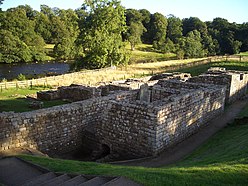Cilurnum
| Cilurnum | |
|---|---|
 |
|
| Founded | 123 AD |
| Attested by | Notitia Dignitatum |
| Province | Britannia |
| — Stone structure — | |
| — Cohorts — | |
| — Alae — | |
| I Augusta ? | |
| Coordinates | 55°01′34″N 2°08′20″W / 55.026°N 2.139°W |
| County | Northumberland |
| Country | England |
| UK-OSNG reference | NY911701 |
Coordinates: 55°01′34″N 2°08′20″W / 55.026°N 2.139°W
Cilurnum or Cilurvum was a fort on Hadrian's Wall mentioned in the Notitia Dignitatum. It is now identified with the fort found at Chesters (also known as Walwick Chesters to distinguish it from other sites named Chesters in the vicinity) near the village of Walwick, Northumberland, England. It was built in 123 AD, just after the wall's completion.
Cilurnum is considered to be the best preserved Roman cavalry fort along Hadrian's Wall. The site is now preserved by English Heritage as Chester's Roman Fort. There is a museum on the site, housing finds from the fort and elsewhere along the wall.
The site guarded a bridge, Chesters Bridge, carrying the Military Way Roman road behind the wall across the River North Tyne. Massive abutments survive of this bridge across the river from the fort. Cilurnum was a cavalry fort at its foundation, for retaliatory raids into barbarian areas north of the wall, then given over to infantry later. Hadrian himself encouraged the "Cult of Disciplina" amongst legions stationed at the wall, and an early inscription on an altar dedicated to Disciplina, found in 1978, indicates the earliest known military presence was a wing of cavalry, ala Augusta ob virtutem appellata ("named Augusta because of its valour"). Inscriptions have also been found showing the First Cohort of Dalmatians, from present-day Bosnia-Herzegovina(Yugoslavia), and the First Cohort of Vangiones from Upper Rhineland in Germany were also stationed here.
...
Wikipedia

